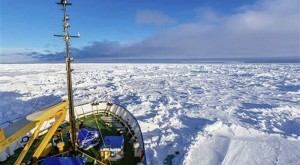Ship involved in Antarctic rescue faces trouble
CANBERRA, Australia — An Australian icebreaker carrying 52 passengers who were retrieved from an icebound ship in the Antarctic was told to halt its journey home on Friday after a Chinese vessel involved in the dramatic rescue became concerned that it, too, may get stuck in the heavy sea ice.
The icebreaker Aurora Australis had been slowly cracking through thick ice toward open water after a Chinese helicopter on Thursday plucked the passengers from their stranded Russian research ship and carried them to the Aurora.
But on Friday afternoon, the crew of a Chinese icebreaker that had provided the helicopter said they were worried about their own ship’s ability to move through the ice. The Aurora — which was carrying the passengers to the Australian island state of Tasmania — was told to stay in the area in case the Chinese icebreaker Snow Dragon needs help, according to the Australian Maritime Safety Authority’s Rescue Coordination Centre, which oversaw the rescue.
The Snow Dragon, which is at the edge of the ice pack surrounding the Russian vessel, will attempt to push through the ice to open water on Saturday. The Aurora is waiting around 11 kilometers (7 miles) north of the Snow Dragon, said Lisa Martin, spokeswoman for the marine authority.
The agency said the decision to place the Aurora on standby was a precaution and noted there was no danger to anyone on board the Snow Dragon. But it was yet another wrinkle in the highly complex rescue operation of those on board the Russian ship MV Akademik Shokalskiy, which got stuck in the ice on Christmas Eve.
Article continues after this advertisementA spot of clear weather on Thursday finally allowed the multinational rescue operation after blinding snow, strong winds and thick sea ice forced rescuers to turn back time and again.
Article continues after this advertisementThe twin-rotor helicopter, which is based on the Snow Dragon, took seven hours to carry the scientists and tourists in groups of 12 from the Russian ship to the Aurora. Earlier, the passengers had linked arms and stomped out a landing site in the snow next to the Russian ship for the helicopter.
Helicopter pilot Jia Shuliang told China’s official Xinhua News Agency that he had no way of knowing whether the ice could withstand the helicopter’s weight.
The rescue came in the never-ending daylight of summer after days of failed attempts to reach the vessel.
“I think everyone is relieved and excited to be going on to the Australian icebreaker and then home,” expedition leader Chris Turney told The Associated Press by satellite phone from the Antarctic.
Sydney resident Joanne Sim, a paying passenger, wept as she boarded the Australian icebreaker. She said the passengers had spent their time watching movies and playing games.
“It really has been an emotional rollercoaster,” she told a reporter from The Sydney Morning Herald newspaper who is aboard the ship.
The 22 crew members of the Akademik Shokalskiy stayed with the icebound vessel, which is not in any danger and has enough supplies on board to last for weeks. They will wait until the ice surrounding the ship breaks up, which could take several weeks, ASMA Emergency Response Division manager John Young said.
The cost of the rescue would be carried by the owners of the ships and their insurers, in accordance with international conventions on sea rescues, Young said.
Any official inquiry into how the ship got stuck would have to be conducted by Russia, he said.
The Akademik Shokalskiy, which left New Zealand on Nov. 28, got stuck after a blizzard pushed the sea ice around the ship, freezing it in place about 2,700 kilometers (1,700 miles) south of Hobart, Tasmania. The scientific team on board the Russian vessel had been recreating Australian explorer Douglas Mawson’s 1911 to 1913 voyage to Antarctica.
